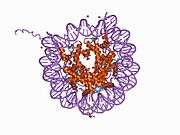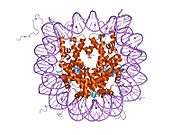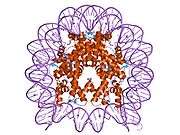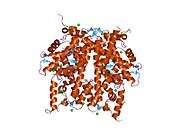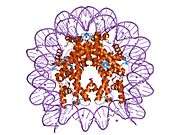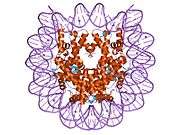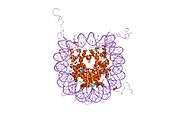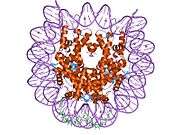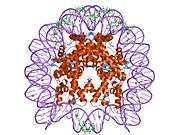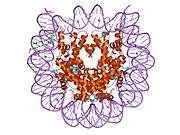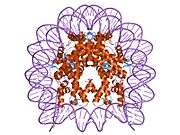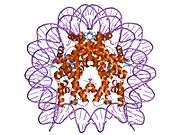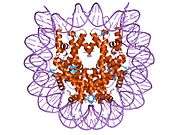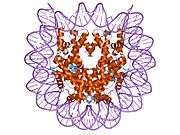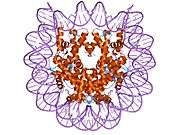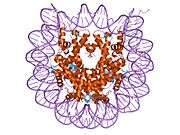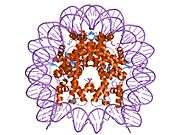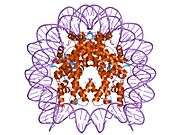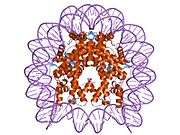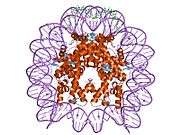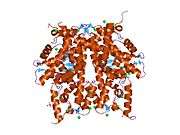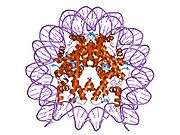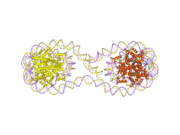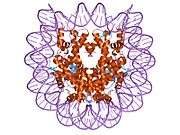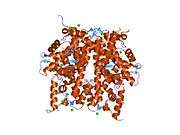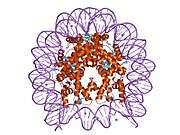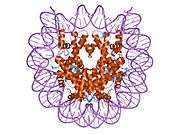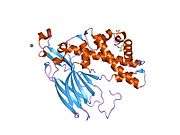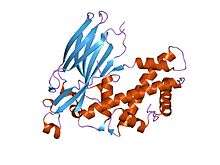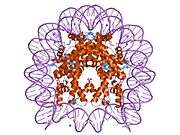HIST2H4A
Histone H4 is a protein that in humans is encoded by the HIST2H4A gene.[5][6][7][8]
Histones are basic nuclear proteins that are responsible for the nucleosome structure of the chromosomal fiber in eukaryotes. This structure consists of approximately 146 bp of DNA wrapped around a nucleosome, an octamer composed of pairs of each of the four core histones (H2A, H2B, H3, and H4). The chromatin fiber is further compacted through the interaction of a linker histone, H1, with the DNA between the nucleosomes to form higher order chromatin structures. This gene is intronless and encodes a member of the histone H4 family. Transcripts from this gene lack polyA tails; instead, they contain a palindromic termination element. This gene is found in a histone cluster on chromosome 1. This gene is one of four histone genes in the cluster that are duplicated; this record represents the centromeric copy.[8]
References
- 1 2 3 GRCh38: Ensembl release 89: ENSG00000270882 - Ensembl, May 2017
- 1 2 3 GRCm38: Ensembl release 89: ENSMUSG00000069266 - Ensembl, May 2017
- ↑ "Human PubMed Reference:".
- ↑ "Mouse PubMed Reference:".
- ↑ Pauli U, Chrysogelos S, Stein G, Stein J, Nick H (Jul 1987). "Protein-DNA interactions in vivo upstream of a cell cycle-regulated human H4 histone gene". Science. 236 (4806): 1308–11. doi:10.1126/science.3035717. PMID 3035717.
- ↑ Sierra F, Stein G, Stein J (Dec 1983). "Structure and in vitro transcription of a human H4 histone gene". Nucleic Acids Res. 11 (20): 7069–86. doi:10.1093/nar/11.20.7069. PMC 326439. PMID 6314274.
- ↑ Braastad CD, Hovhannisyan H, van Wijnen AJ, Stein JL, Stein GS (Nov 2004). "Functional characterization of a human histone gene cluster duplication". Gene. 342 (1): 35–40. doi:10.1016/j.gene.2004.07.036. PMID 15527963.
- 1 2 "Entrez Gene: HIST2H4A histone cluster 2, H4a".
Further reading
- Green L, Van Antwerpen R, Stein J, et al. (1984). "A major human histone gene cluster on the long arm of chromosome 1". Science. 226 (4676): 838–40. doi:10.1126/science.6494913. PMID 6494913.
- Pelicci G, Lanfrancone L, Salcini AE, et al. (1995). "Constitutive phosphorylation of Shc proteins in human tumors". Oncogene. 11 (5): 899–907. PMID 7675449.
- Díaz-Jullien C, Pérez-Estévez A, Covelo G, Freire M (1996). "Prothymosin alpha binds histones in vitro and shows activity in nucleosome assembly assay". Biochim. Biophys. Acta. 1296 (2): 219–27. doi:10.1016/0167-4838(96)00072-6. PMID 8814229.
- Rodriguez P, Munroe D, Prawitt D, et al. (1997). "Functional characterization of human nucleosome assembly protein-2 (NAP1L4) suggests a role as a histone chaperone". Genomics. 44 (3): 253–65. doi:10.1006/geno.1997.4868. PMID 9325046.
- Albig W, Doenecke D (1998). "The human histone gene cluster at the D6S105 locus". Hum. Genet. 101 (3): 284–94. doi:10.1007/s004390050630. PMID 9439656.
- El Kharroubi A, Piras G, Zensen R, Martin MA (1998). "Transcriptional activation of the integrated chromatin-associated human immunodeficiency virus type 1 promoter". Mol. Cell. Biol. 18 (5): 2535–44. doi:10.1128/mcb.18.5.2535. PMC 110633. PMID 9566873.
- Kimura A, Horikoshi M (1999). "Tip60 acetylates six lysines of a specific class in core histones in vitro". Genes Cells. 3 (12): 789–800. doi:10.1046/j.1365-2443.1998.00229.x. PMID 10096020.
- Deng L, de la Fuente C, Fu P, et al. (2001). "Acetylation of HIV-1 Tat by CBP/P300 increases transcription of integrated HIV-1 genome and enhances binding to core histones". Virology. 277 (2): 278–95. doi:10.1006/viro.2000.0593. PMID 11080476.
- Seo SB, McNamara P, Heo S, et al. (2001). "Regulation of histone acetylation and transcription by INHAT, a human cellular complex containing the set oncoprotein". Cell. 104 (1): 119–30. doi:10.1016/S0092-8674(01)00196-9. PMID 11163245.
- Deng L, Wang D, de la Fuente C, et al. (2001). "Enhancement of the p300 HAT activity by HIV-1 Tat on chromatin DNA". Virology. 289 (2): 312–26. doi:10.1006/viro.2001.1129. PMID 11689053.
- Andersen JS, Lyon CE, Fox AH, et al. (2002). "Directed proteomic analysis of the human nucleolus". Curr. Biol. 12 (1): 1–11. doi:10.1016/S0960-9822(01)00650-9. PMID 11790298.
- Weinmann AS, Yan PS, Oberley MJ, et al. (2002). "Isolating human transcription factor targets by coupling chromatin immunoprecipitation and CpG island microarray analysis". Genes Dev. 16 (2): 235–44. doi:10.1101/gad.943102. PMC 155318. PMID 11799066.
- Marzluff WF, Gongidi P, Woods KR, et al. (2003). "The human and mouse replication-dependent histone genes". Genomics. 80 (5): 487–98. doi:10.1016/S0888-7543(02)96850-3. PMID 12408966.
- Strausberg RL, Feingold EA, Grouse LH, et al. (2003). "Generation and initial analysis of more than 15,000 full-length human and mouse cDNA sequences". Proc. Natl. Acad. Sci. U.S.A. 99 (26): 16899–903. doi:10.1073/pnas.242603899. PMC 139241. PMID 12477932.
- Hovhannisyan H, Cho B, Mitra P, et al. (2003). "Maintenance of open chromatin and selective genomic occupancy at the cell cycle-regulated histone H4 promoter during differentiation of HL-60 promyelocytic leukemia cells". Mol. Cell. Biol. 23 (4): 1460–9. doi:10.1128/MCB.23.4.1460-1469.2003. PMC 141140. PMID 12556504.
- Yoon HG, Chan DW, Huang ZQ, et al. (2003). "Purification and functional characterization of the human N-CoR complex: the roles of HDAC3, TBL1 and TBLR1". EMBO J. 22 (6): 1336–46. doi:10.1093/emboj/cdg120. PMC 151047. PMID 12628926.
- Pivot-Pajot C, Caron C, Govin J, et al. (2003). "Acetylation-dependent chromatin reorganization by BRDT, a testis-specific bromodomain-containing protein". Mol. Cell. Biol. 23 (15): 5354–65. doi:10.1128/MCB.23.15.5354-5365.2003. PMC 165724. PMID 12861021.
- Coleman MA, Miller KA, Beernink PT, et al. (2004). "Identification of chromatin-related protein interactions using protein microarrays". Proteomics. 3 (11): 2101–7. doi:10.1002/pmic.200300593. PMID 14595808.





